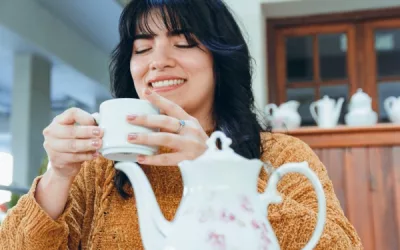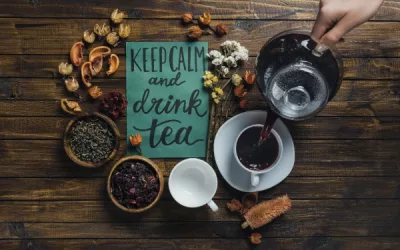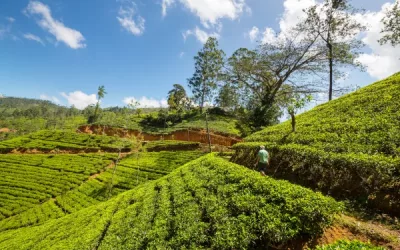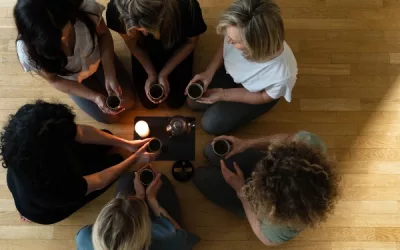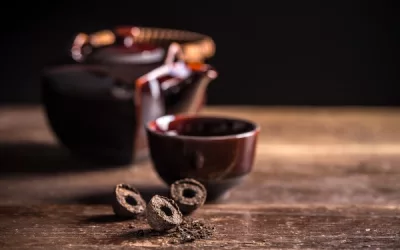Did you know that tea, often seen as a soothing beverage, actually has varying caffeine levels that can rival that of coffee? Understanding the caffeine content in tea is essential, especially for those monitoring their intake for health reasons. This article will guide you through the intricacies of caffeine in different teas, debunk common myths, and explore how brewing time and brands influence caffeine levels. By the end, you’ll know exactly how to enjoy your favourite tea while managing your caffeine consumption effectively.
Table of Content
- What types of tea contain caffeine?
- How does brewing time affect caffeine levels in tea?
- Are herbal teas truly caffeine-free?
- How do different brands affect caffeine content in tea?
- How does caffeine in tea compare to caffeine in coffee?
- What are the health effects of caffeine in tea?
- How can you control caffeine intake from tea?
- What common myths exist about caffeine in tea?
- Is it true that all teas contain caffeine?
- Does caffeine in tea lead to dehydration?
- Are there any myths about the health effects of tea caffeine?
- Conclusion
What types of tea contain caffeine?
Teas like black tea, green tea, oolong tea, white tea, and matcha contain caffeine. These teas come from the Camellia sinensis plant and naturally have caffeine. However, the caffeine content varies depending on the type of tea and the processing methods used.
Tea enthusiasts and health-conscious individuals often wonder about the caffeine content in various teas. Whether you’re looking for a morning energy boost or a calming evening brew, knowing the caffeine levels in different types of tea can guide your choices.
How does the caffeine content vary among these types of tea?
The caffeine levels in tea fluctuate based on factors like preparation, type of leaves, and brewing time. Here’s a breakdown of how caffeine content varies among popular teas:
- Black tea: Known for its robust flavour, black tea has the highest caffeine content among traditional teas.
- Green tea: Slightly lower in caffeine than black tea, green tea is favoured for its refreshing taste and health benefits.
- Oolong tea: This tea falls between black and green tea in terms of caffeine level, offering a unique flavour profile.
- White tea: Often considered the least processed, white tea typically has the lowest caffeine content among these teas.
- Matcha: This powdered green tea stands out due to its high caffeine content, as you consume the entire leaf when drinking matcha.
The caffeine content in tea isn’t fixed; multiple elements can affect it. Though generally, black tea and matcha have higher levels, green, oolong, and white teas can also provide a caffeine boost, depending on their preparation.
Which type of tea has the highest caffeine content?
When discussing the highest caffeine levels in traditional teas, black tea often tops the list. However, matcha significantly surpasses black tea in caffeine content. Matcha contains high amounts of caffeine due to the powdered form, which involves consuming the whole leaf, rather than an infusion.
- Preparation method: Matcha includes consuming powdered leaves, leading to higher caffeine intake.
- Leaf processing: Black tea leaves are fully oxidised, enhancing their caffeine level.
- Leaf size: Finer tea leaves and buds tend to have more caffeine compared to larger leaves.
- Brewing time: Longer brew times extract more caffeine into the tea.
In summary, matcha has the highest caffeine content due to its preparation method, followed by black tea. This makes matcha an exceptional choice for those needing a significant caffeine spike.
Are there any exceptions to these general caffeine levels?
While these general guidelines apply to most teas, some exceptions exist. Not all teas conform to standard caffeine levels due to specific factors like processing techniques, environmental conditions, and blend compositions.
- Herbal teas: These teas, like chamomile, rooibos, and peppermint, don’t come from the Camellia sinensis plant and typically contain no caffeine.
- Caffeinated herbal blends: Some herbal teas can have added caffeine or be blended with caffeinated teas.
- Decaffeinated teas: Regular teas from Camellia sinensis can undergo a decaffeination process that removes most of the caffeine content.
- Shade-grown tea leaves: Some teas grown in the shade, such as certain green teas, possess higher caffeine levels due to increased chlorophyll production.
Given these exceptions, tea drinkers can find blends that meet their specific caffeine preferences, whether aiming for high or low levels.
In the late 1600s, the Dutch East India Company introduced tea to Europe, captivating the British aristocracy. As tea became ingrained in British culture, afternoon tea emerged, a ritual that often centred around high-caffeine black teas.
Catherine of Braganza, the Portuguese wife of King Charles II, is often credited with popularising tea in England. Her influence reshaped British social customs, making tea a prominent feature in British daily life.
How does brewing time affect caffeine levels in tea?
Brewing time plays a significant role in determining the caffeine content of your tea. The longer you steep your tea leaves, the more caffeine is extracted into your brew. This connection is especially relevant for tea enthusiasts and those monitoring their caffeine intake, as different types of tea can vary significantly in their caffeine highs and lows.
When you steep your tea for a shorter duration, you get a lighter brew with less caffeine. Conversely, letting your tea steep longer results in a stronger, more caffeine-packed cup.
This table below explains the relationship between brewing time and caffeine levels across various types of tea. It can help you decide how long you’d like to steep your tea based on your caffeine preferences.
Brewing Time, Tea Type, and Caffeine Content
| Tea Type | Brewing Time (minutes) | Caffeine Content (mg) |
|---|---|---|
| White Tea | 2-3 min. | 15-30 |
| White Tea | 5-7 min. | 30-45 |
| Green Tea | 2-3 min. | 20-35 |
| Green Tea | 5-7 min. | 35-50 |
| Oolong Tea | 2-3 min. | 30-50 |
| Oolong Tea | 5-7 min. | 50-70 |
| Black Tea | 2-3 min. | 40-60 |
| Black Tea | 5-7 min. | 60-90 |
| Pu-erh Tea | 2-3 min. | 12-18 |
| Pu-erh Tea | 5-7 min. | 18-30 |
| Herbal Tea | 2-3 min. | 0 |
| Herbal Tea | 5-7 | 0 |
To use this table, identify the type of tea you’re brewing and then decide on a brewing time, which ranges from 2-3 minutes for a lighter cup to 5-7 minutes for a stronger one.
The corresponding caffeine content column provides you with an idea of how much caffeine you can expect in each cup based on the steeping time. This knowledge can help you tailor your tea brewing habits to suit your caffeine needs and preferences.
Why does brewing time impact caffeine levels?
When you steep tea, you are essentially soaking the tea leaves in hot water, which extracts the essential compounds that give tea its flavour and caffeine content. The longer the leaves remain in the water, the more these compounds dissolve and intensify.
- Tea type matters: Different tea types—white, green, oolong, black, pu-erh, and herbal—contain varying amounts of caffeine to begin with.
- Temperature counts: Warmer water extracts caffeine and other compounds faster than cool or tepid water.
- Leaf quality: Whole leaf teas tend to release caffeine more efficiently over time compared to tea bags or broken leaves.
- Leaf quantity: More tea leaves in your brew can increase the caffeine concentration regardless of steeping time.
Understanding these factors can help you manipulate your tea for desired caffeine levels, making your tea experience more tailored and enjoyable.
How can you control caffeine intake through tea brewing?
Knowing the influence of brewing time on caffeine levels lets you take control of your caffeine consumption. This can be particularly useful if you’re sensitive to caffeine or wish to limit your intake.
- Start with a short steep: Steeping for 2-3 minutes can result in a lighter, less caffeinated cup.
- Increase leaf amount gradually: If you’re using loose leaves, you can add more leaves to your brew for a stronger cup without significantly extending brewing time.
- Experiment with multiple infusions: Some teas, like oolong and pu-erh, can be steeped multiple times, with each brew having progressively lower caffeine levels.
- Opt for herbal teas: Herbal teas are naturally caffeine-free, making them a perfect choice for those wishing to avoid caffeine altogether.
By experimenting with these methods, you can discover the perfect balance that suits your taste and caffeine needs.
In the late 18th century, British colonialists in India discovered and began to cultivate Camellia sinensis (the tea plant). During this period, they understood the importance of optimal brewing time for a rewarding cup.
The Assam tea gardens became famous for robust black tea, loved by the British for its stronger caffeine kick. Gardeners realised that a longer brew released more of the potent stimulating alkaloids, including caffeine, which became a sought-after property of Indian teas. This historical context underpins why understanding brewing time and caffeine levels remains essential for an ideal tea experience.
Speaking from personal experience, I remember my first encounter with white tea. I usually brewed black tea which I would steep for 5 minutes to get that rich flavour and caffeine boost.
However, when I prepared white tea for the first time, I used the same brewing duration. The resultant cup was extremely bitter and too strong for my liking. I quickly learnt that a shorter steeping time of around 3 minutes suited the delicate nature of white tea.
It made my tea experience vastly more enjoyable and taught me that not all teas benefit from long brewing times.
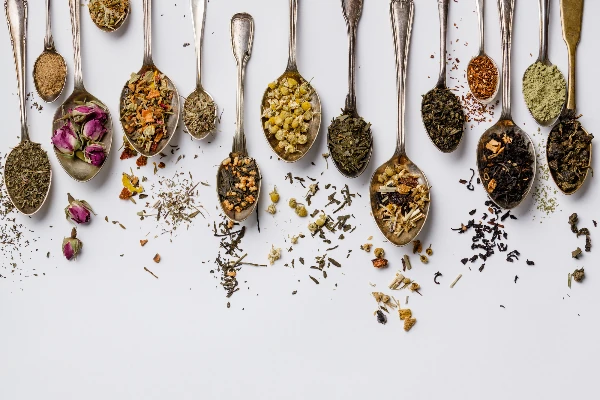
Are herbal teas truly caffeine-free?
Let’s get straight to the punchline: yes! Herbal teas are typically caffeine-free. However, the devil’s in the details, so let’s dive further into the wonderful world of herbal infusions.
Herbal teas are like that cool cousin who shows up at family gatherings with a unique flair. They’re not made from traditional tea leaves but from a delightful mix of herbs, fruits, flowers, and spices.
Imagine sipping on a chamomile tea that’s as calming as a lullaby, a peppermint brew that’s as refreshing as a cool breeze, or a vibrant hibiscus tea that brings a punch of tartness and colour to your day.
These are just a few of the herbal teas that people love.
What plants are used to make herbal teas?
Herbal teas are like a botanical garden in your cup. They feature a wide range of plant materials:
- Chamomile flowers: Known for calming properties.
- Peppermint leaves: Has a refreshing, minty taste.
- Rooibos: A South African bush, known for its reddish colour and sweet, nutty flavour.
- Hibiscus flowers: Produces a tart, cranberry-like flavour and a bright red hue.
- Lavender flowers: Often used for a relaxing and aromatic experience.
- Lemongrass: Adds a zesty lemon flavour.
- Ginger root: Provides a spicy, warming kick.
- Rose hips: The fruit of the rose plant, known for its tangy and slightly sweet taste.
- Dandelion root: Used for its earthy and slightly bitter profile.
Herbal teas can be cosy, refreshing, or adventurous. But they never bring the caffeine jolt that traditional teas do.
Are there any herbal teas that contain caffeine?
Alright, let’s not dance around it: there are a couple of impostors in the herbal tea world. While most herbal teas are caffeine-free, some outliers sneak into the mix.
- Yerba mate: Packed with energy-boosting properties, often appreciated by those who enjoy the stimulant effect of caffeine.
- Guayusa: Another South American caffeine-packed tea.
- Yaupon: A North American tea with natural caffeine content.
So, if you’re going for strictly caffeine-free, better keep an eye out for these sneaky culprits. But for many, these teas offer a natural lift without the caffeine crash.
How do herbal teas differ from traditional teas in terms of caffeine?
Imagine a bustling party: traditional teas are the energetic folks buzzing with caffeine, while herbal teas are the laid-back guests enjoying the scene without the buzz.
Key differences in caffeine:
- Camellia sinensis leaves: All traditional teas (black, green, white, oolong) come from these leaves, which naturally contain caffeine.
- Herbal infusions: Typically caffeine-free as they’re not made from tea leaves but rather a blend of various plants.
- Energy levels: Traditional teas give you a caffeine kick, herbal teas don’t.
- Brewing: Both types are brewed by steeping in hot water, but with herbal teas, you’re extracting flavours from non-tea plants.
- Purpose: Traditional teas are often consumed for their caffeine and antioxidants, while herbal teas are favoured for relaxation, digestion, and a myriad of other health benefits without the caffeine-induced jitters.
To sum it up, if you’ve had enough of caffeine making you jittery or restless, herbal teas are the way to go.
The world of teas is vast and diverse. Speaking of variety, did you know about the Boston Tea Party in 1773? Here’s the deal: upset with the British tax on tea, American colonists (disguised as Mohawk Indians) boarded ships in Boston Harbour and dumped 342 chests of precious tea into the water.
It was a rebellious tea party that shouted down British rule and paved the way for American independence. So next time you sip on your chamomile, perhaps you can toast to the audacious history of rebellion it harbours within those tea leaves—even if it’s caffeine-free.
How do different brands affect caffeine content in tea?
Ah, the age-old dilemma of tea drinkers: to caffeinate or not to caffeinate, that is the question. And believe it or not, the brand of tea you choose can have a significant impact on how jittery (or zen) you’ll be after your cuppa.
Different tea brands source their leaves from various parts of the globe, each with its own unique set of flavour profiles, cultivation techniques, and yes, caffeine content. For instance, some tea brands source leaves from high-altitude regions in Darjeeling, where the cooler climate yields leaves with subtler flavours but often higher caffeine content. Conversely, a fair-trade brew from a small, sun-soaked farm in Sri Lanka might pack a much milder buzz.
Processing methods also play a chunky role. To put it bluntly, the more a leaf is processed, the more its caffeine varies. Intense oxidation processes generally result in higher caffeine content, mainly because those processing methods are used to make black teas, which naturally have more caffeine than, say, your gentle chamomile brew.
Then there are the blends. So, your favourite minty chai might be hiding more caffeine than you bargained for, especially if it’s mixed with high-caffeine black tea. Individual brands have their own unique blend recipes, which can lead to caffeine levels that are as unpredictable as a British summer.
What should consumers look for when choosing a low-caffeine brand?
To avoid turning into a human pogo stick after a simple cuppa, there are a few tricks you should keep up your sleeve.
- Check for herbal and decaf labels: Herbal teas like chamomile, rooibos, and peppermint are generally caffeine-free. Decaf versions of your classic favourites like Earl Grey are also widely available.
- Read the fine print: Look for detailed descriptions on the packaging. Some brands are transparent about their caffeine content.
- Beware of blends: Simple blends often contain fewer surprises. If caffeine’s a concern, stick to single-ingredient teas.
- Research the source: Teas sourced from regions known for lower caffeine levels are a safer bet.
- Opt for white or green teas: These naturally have less caffeine compared to black or oolong teas.
Understanding these basics can help you pick a brand that aligns with your aim of keeping the caffeine levels to a minimum. Once you’re aware of these factors, dodging those caffeine-infused bullets becomes second nature.
Are there any brands known for their low caffeine content?
Absolutely, some tea brands are practically shouting, “We won’t keep you up all night!” from the rooftops.
- Pukka Herbs: Famous for their herbal blends that focus on relaxation and wellness. Most of their teas are inherently caffeine-free.
- Celestial Seasonings: Known for their variety of herbal teas, especially the Sleepytime range which is perfect for evening unwinding.
- Yogi Tea: This brand offers a range of options, with many leaning towards the low-caffeine side of the scale.
- Tazo Teas: While they offer a range of caffeinated options, their specific herbal blends like Passion are big hits with those steering clear of caffeine.
- Twinings: Their selection of decaf teas provides traditional flavours without the jittery kick.
These brands have options carefully curated to ensure delightful flavour experiences minus the caffeine overload. Once you know where to look, finding the perfect low-caffeine option isn’t rocket science—just good tea sense.
How can consumers verify caffeine content in their tea?
There’s nothing more frustrating than trying to decode a tea label that looks like it belongs on a NASA spaceship. Fortunately, there are several ways to confirm what’s actually in your cup.
- Label inspection: Yes, some labels will straight-up tell you the caffeine content. Seek and you shall find.
- Visit the brand’s website: Brands often provide detailed information online that’s missing from the packaging.
- Third-party reviews: People love to share their experiences online, so read customer reviews or blog posts.
- Contact customer service: Reach out directly to the brand for the most accurate information.
- Use a caffeine tester kit: For the truly paranoid, caffeine testing kits are available for home use to get a precise measurement.
So, before you find yourself wide-eyed at 3 AM pondering the existence of extraterrestrial life, make use of these strategies to ensure your tea stays comfortably within your preferred caffeine limit.
In the 1800s, Sir Thomas Lipton, the Scottish tea magnate, decided to shake up the tea industry by cutting out the middleman and sourcing his tea directly from the highlands of what is now Sri Lanka.
Not only did this result in more affordable tea, but it also introduced varying levels of caffeine content depending on the altitude and processing methods used. This innovative approach democratized tea drinking and laid the groundwork for the wide array of brews we enjoy today, each with its own unique punch—or lack thereof.
So, next time you take a sip, remember: your choice of tea brand is more than just flavour; it’s a legacy of innovation that even Sir Thomas himself would toast to. Cheers!
How does caffeine in tea compare to caffeine in coffee?
Did you know your daily cuppa holds secrets about its caffeine content? Yep, tea isn’t just your grandmum’s favourite beverage—it packs a caffeinated punch too! But how does this kick compare to a shot of espresso? Let’s break it down and spill the tea on how these two popular drinks measure up when it comes to caffeine.
First things first, the caffeine content. A standard cup of tea usually contains between 20-60 milligrams of caffeine, whereas your average cup of coffee ranges from 95-200 milligrams. Yep, that’s quite a difference! Tea gets its caffeine from the leaves of the Camellia sinensis plant, while coffee’s jolt comes from the seeds of the Coffea plant. Despite both giving you that needed boost, they differ significantly in quantity and effect on your body.
Why might someone choose tea over coffee regarding caffeine?
Let’s face it: sometimes, you don’t need a caffeine jolt that could wake the dead. You might prefer a gentler lift rather than the rocket-fuel that coffee can be. Here’s why opting for tea might be your cup of, well, tea.
- Lower Caffeine Content: Tea provides a moderate caffeine boost, perfect for those who find coffee overwhelming.
- Gradual Release: The presence of L-theanine in tea helps release caffeine slowly, offering a steady, prolonged energy lift.
- Reduced Jitters: Fewer caffeine spikes mean fewer jitters and crashes.
- Better Hydration: While both tea and coffee are diuretics, tea is typically less dehydrating.
- Added Antioxidants: Tea is rich in antioxidants like catechins, which have numerous health benefits.
It’s not just about choosing one over the other, it’s about finding what works for you. If you’re looking to cut down on caffeine but still need a bit of a morning or afternoon boost, tea might be your best bet.
What are the health implications of caffeine from tea versus coffee?
Now, let’s chew over the health side of things. Both beverages can be a part of a balanced diet, but they come with their own set of pros and cons.
- Heart Health: Tea, especially green tea, has been linked to better heart health thanks to its high level of antioxidants.
- Digestive Issues: Coffee can be harsher on the stomach, sometimes causing acid reflux or irritation.
- Bone Health: High coffee intake might leach calcium from bones, while tea seems to have less of an impact.
- Mental Alertness: Both improve mental focus, but the L-theanine in tea promotes a state of calm alertness.
- Cancer Risk: Some studies suggest tea, particularly green tea, may reduce certain cancer risks thanks to its antioxidants.
When it comes to health, both tea and coffee have their virtues. Your choice might depend on what you can tolerate and which health benefits align with your lifestyle goals.
How do the caffeine effects of tea and coffee differ?
Ever noticed how your reaction to a cup of tea versus a cup of coffee differs? It’s not your imagination; these beverages hit your system in unique ways thanks to their caffeine content and other compounds.
- Speed of Absorption: Coffee’s caffeine is absorbed quickly, giving you an immediate jolt.
- Duration of Effect: Tea’s caffeine releases more gradually due to the presence of L-theanine, providing a smoother, longer-lasting energy.
- Mood Modulation: Tea can induce a state of calm alertness, while coffee might make you more jittery.
- Energy Peaks and Valleys: Coffee tends to cause sharp energy spikes and crashes, whereas tea offers a more balanced lift.
- Sleep Impact: Tea’s milder caffeine content is less likely to mess with your sleep patterns compared to coffee.
So, if you cringe at the thought of jittery hands and energy crashes, tea might serve you better. But if you need to be instantly awake and alert, coffee could be your go-to.
In 1773, American colonists would have scoffed at the idea of sipping tea leisurely. During the Boston Tea Party, protesters, fed up with British taxes, dumped an entire shipment of the East India Company’s tea into the Boston Harbour.
Imagine the settlers saying, “Keep your taxed tea, we’ll start our mornings with an espresso shot instead!” It was a bold act that swung the pendulum, and while it didn’t dent Britain’s taste for tea, it was a dramatic call for independence. Perhaps it’s this rebellious spirit that still fuels our coffee culture today. Cheers to that!
What are the health effects of caffeine in tea?
Alright, let’s spill the tea (pun intended) on the health effects of caffeine in your favourite cuppa. Turns out, that humble brew isn’t just a tasty pastime—it’s packed with caffeine that can both boost and bust your buzz, depending on how you handle it.
First up, the benefits. Caffeine, found naturally in tea, can give you that much-needed morning kick without making you jitter like a squirrel on energy drinks. It can improve mental alertness, lift your mood, and even help you get through those mind-numbing Zoom calls. Antioxidants in tea also work alongside caffeine to potentially lower the risk of chronic diseases. Nice, right?
But hold your horses! There’s a dark side too. Too much caffeine can mess with your sleep, crank up your anxiety levels, and even put a strain on your ticker. No one wants to be wide-eyed at 3 AM, stressed out, and feeling their heart thumping like it’s auditioning for a drum solo. So, let’s figure out how to sip smartly and avoid the pitfalls.
How much caffeine is considered safe for daily consumption?
So, how much of this jitter juice can you guzzle without turning into a frazzled mess? According to health experts, up to 400 milligrams of caffeine per day is generally considered safe. That’s the equivalent of about 8 cups of green tea or 4 cups of black tea. Yep, you heard that right—you don’t have to swear off your beloved brew!
- Up to 400 mg of caffeine per day is considered safe.
- That’s roughly 4 cups of black tea or 8 cups of green tea.
- The amount of caffeine can vary based on the type of tea and brewing time.
- Herbal teas are virtually caffeine-free.
- Matcha, a type of powdered green tea, can pack a hefty caffeine punch.
Keep in mind that we are all built differently. While some can handle a double espresso without batting an eyelid, just a single cup of tea can send others into overdrive. Know your limits and sip accordingly.
What symptoms may indicate caffeine sensitivity?
Feeling like you’ve had one too many when you’ve only downed a cup or two? You might have a case of caffeine sensitivity. Symptoms can show up faster than you can say “Earl Grey”.
- Jitters and shakes – as if you’ve been hitting the gym when you haven’t.
- Rapid heartbeat or palpitations – enough to make you think you’ve sprinted a marathon.
- Anxiety or restlessness – because who doesn’t like feeling they’re on edge?
- Insomnia – not cute when counting sheep doesn’t help.
- Frequent headaches – the ‘gift’ that keeps on giving.
If these sound familiar every time you indulge in your tea ritual, it might be wise to rethink your intake. No one wants to navigate life in a caffeine-charged daze, right?
Are there specific health conditions that may be affected by caffeine intake?
Tea lovers with existing health conditions, listen up! While tea has many virtues, its caffeine content can play havoc with certain health scenarios.
- Heart conditions – caffeine can ramp up heart rate and blood pressure.
- Anxiety disorders – it can increase anxious thoughts and a heightened sense of worry.
- Insomnia – more caffeine equals less shut-eye, simple math.
- Acid reflux or ulcers – caffeine can irritate the gut lining.
- Pregnancy – best to limit caffeine as it crosses the placenta affecting the baby.
- Heart disease – increased risk of arrhythmia and hypertension.
- General anxiety disorder – heightened nervousness and panic attacks.
- Gastrointestinal issues – exacerbating heartburn and acid reflux.
- Sleep disorders – worsened sleepless nights.
- Pregnancy – caffeine crosses the placenta and can affect fetal development.
Tea drinking can be a delightful and soothing ritual, but those with health concerns need to balance their enthusiasm with their wellbeing.
Did you know? Back in the 17th century, Catherine of Braganza, the Portuguese wife of King Charles II, introduced tea to the British aristocracy. People initially thought of tea as a cure-all. Bright and beautiful, tea quickly became the fashionable beverage of choice, but not without some controversy.
Physicians got alarmed when people began reporting insomnia and stomach issues from those lavish tea parties. So, even in the days of royals and ruffles, the caffeine debate was brewing.
So go ahead, enjoy your beloved tea but keep an eye on those caffeine levels!
How can you control caffeine intake from tea?
Alright, tea enthusiasts, grab your kettles because we’re diving into how you can control your caffeine intake while still enjoying that comforting cup of brew. We all love a good cuppa, but sometimes that caffeine hit can be a bit too much, especially if you’re aiming for a chill, Zen-like vibe.
Strategies for managing your tea’s caffeine kick range from choosing naturally low-caffeine leaves to fiddling with your brewing times and playing mad scientist by mixing different teas. Here’s how you can master your tea game without turning into a jittery mess.
What are some low-caffeine tea options?
You know those days when you want to sip on something soothing, but you don’t want to be awake all night counting sheep? That’s where low-caffeine teas come in. Let’s break down your options:
- Herbal teas: Chamomile, peppermint, and rooibos are your best friends here. They’re naturally caffeine-free and pack a lot of flavour punch.
- White teas: These delicate teas have lower caffeine levels compared to their black and green counterparts. Silver Needle is a classic choice.
- Green teas: Not all greens are created equal. Go for Japanese greens like Genmaicha, which has roasted rice mixed in, reducing the overall caffeine.
- Decaffeinated teas: These are regular teas with most of the caffeine zapped out. However, a small trace of caffeine might still lurk around.
- Oolong teas: Though they can vary, certain oolongs have less caffeine than black teas.
Opting for these options allows you to enjoy your tea rituals sans the excessive caffeine jitters.
How can brewing time be adjusted to reduce caffeine?
You might not be a wizard, but you can magically reduce your tea’s caffeine with a slight alteration in brewing time:
- Shorter steeping: Steep your leaves for just 30 seconds to 1 minute to shave off some caffeine. The longer you steep, the more caffeine you extract.
- Rinse and repeat: A quick rinse of the tea leaves before the actual steeping can wash out some of that caffeine.
- Temperature matters: Lowering the water temperature can also be your ally. Hotter water extracts more caffeine, so aim for around 70-80°C instead of boiling.
With these tricks, you’ll maintain the flavour without the caffeine overdrive, making your evenings a little less caffeinated and a lot more chill.
Can mixing different teas help in controlling caffeine levels?
Ever considered blending your teas to balance caffeine levels? It’s like having your cake and eating it too. Playing mixologist with your tea stash can yield delicious and caffeine-controlled concoctions:
- Blend herbal with black teas: Mixing robust black teas with herbal teas like peppermint can mellow out the caffeine spike.
- Green with white teas: Green tea has more caffeine, but blending it with white tea can balance the overall caffeine content.
- Rooibos mix-ins: Rooibos, being caffeine-free, is perfect for cutting down the caffeine in other teas without losing out on body and taste.
- Custom decaf blends: Combining decaffeinated teas with regular ones can give you the desired flavour profile while keeping caffeine in check.
By experimenting with different tea blends, you can enjoy a unique brew that aligns with your caffeine tolerance and flavour preferences.
In the early 1900s, renowned tea merchant Sir Thomas Lipton embarked on a journey to create the perfect tea blend to capture the American market. What many don’t know is that his meticulous blending strategies weren’t just about flavour but balancing caffeine levels too.
He understood that the American palate required a gentler caffeine experience compared to the robust British brews. By mixing various teas and perfecting the art of blending, Lipton not only won over taste buds but also made his mark on tea history.
His efforts remind us that with a bit of creativity, we can tailor our tea to suit our exact needs. So go on, channel your inner Lipton and blend away!
What common myths exist about caffeine in tea?
Alright, let’s spill the tea on some of the most common myths surrounding caffeine in your beloved brew. If you’ve ever heard that all teas are packed with caffeine or that they turn your mouth into the Sahara Desert, you’re in for a surprise. Let’s chop these myths into tiny little pieces, shall we?
First off, not all teas are born with a caffeine punch. Some are as calm as a monk while others are caffeine-packed party animals. Thinking your Earl Grey is going to have the same effect as chamomile before bed is like expecting a rock concert to be as relaxing as a yoga class.
Secondly, if you’re convinced tea will suck every drop of moisture out of your body, brace yourself for some myth-busting. Caffeine in tea won’t turn you into a prune. It’s actually quite hydrating; your body isn’t going to start begging for a water parade after every cup.
Lastly, let’s address the big health scare some folks might have. The idea that caffeine from tea is going to wreak havoc on your health like it has a personal vendetta against you is just plain wrong. Not only is it less aggressive than coffee’s caffeine, but it also comes with a boatload of antioxidants that are like little health warriors.
Is it true that all teas contain caffeine?
Nope, not all teas are caffeine fiends. You’ve got an entire spectrum out there, from hyperactive disco teas to zen-like brews.
- Herbal teas: Most of these, like chamomile and peppermint, are caffeine-free.
- Green tea: Contains caffeine, but usually less than black tea.
- Black tea: Generally has the highest caffeine content among traditional teas.
- White tea: Often has the least caffeine of the traditional teas.
- Decaffeinated teas: These are traditional teas that have had most of the caffeine removed.
So, the next time someone tells you all teas are caffeinated, kindly pour a cup of chamomile and enjoy their surprised reaction.
Tea’s diversity is like a box of chocolates, you never know what you’re gonna get. But one thing’s for sure: you’ve got options if you’re looking to cut back on the caffeine without cutting out your comforting cuppa.
Does caffeine in tea lead to dehydration?
Here’s another myth that needs to be steeped out. While caffeine has a mild diuretic effect, it doesn’t turn your body into a desert.
- Hydration: Tea is mostly water, so it helps keep you hydrated.
- Moderate diuretic effect: Yes, caffeine has some diuretic properties, but not enough to cause dehydration.
- Less caffeine than coffee: Tea usually contains less caffeine compared to coffee, making its diuretic effect even more negligible.
- Other hydrating options: Herbal teas and decaffeinated teas add variety without adding to caffeine worries.
So, unless you’re chugging tea by the gallon while living in a sauna, you’re more likely to stay hydrated than to dry out.
The bottom line is that tea won’t leave you high and dry. A moderate amount will actually help keep you hydrated throughout the day. Plus, it makes your water intake way more interesting than plain old H₂O.
Are there any myths about the health effects of tea caffeine?
Oh, absolutely. Let’s debunk the idea that caffeine in tea is out to ruin your health like a supervillain.
- Heart health: Moderate tea consumption can actually be good for your heart.
- Antioxidants: Tea is loaded with these bad boys, especially green tea.
- Mental alertness: Caffeine can boost focus without the jitters coffee often brings.
- Weight management: Some teas like green tea can have a mild effect on metabolism.
- Bone health misconceptions: Contrary to some beliefs, moderate tea drinking doesn’t ruin your bones.
Tea isn’t just a comforting drink; it’s also packed with benefits that can contribute to overall well-being. The caffeine in tea is part of this balanced health cocktail.
Now, let’s take a trip back to the 17th century. Did you know that tea was initially considered a medicine in Britain? When tea first arrived on English shores, it was sold in apothecaries, not grocery stores.
Doctors of the time swore by its medicinal properties, believing it could cure everything from headaches to digestion issues. So next time you sip your tea, remember you’re partaking in a centuries-old health tradition recognised for its benefits, even back in the day. Cheers to that!
Conclusion
In wrapping up our exploration of caffeine levels in various types of tea, it becomes apparent that tea is not just a simple beverage, but a complex tapestry woven from different types and brewing methods.
We’ve delved into the varying caffeine contents of black, green, oolong, white, and matcha teas, each bringing its own unique character and impact on our caffeine intake.
It’s fascinating to note that while black tea generally contains the highest caffeine levels, factors like brewing time can significantly alter this picture. Our analysis reveals that even the same tea can deliver different caffeine experiences based on how long it’s steeped.
Equally intriguing are our findings on herbal teas, which stand apart as caffeine-free alternatives. While they originate from a variety of plants and offer a multitude of flavours, understanding their distinctions from traditional teas enhances our appreciation for what we drink.
The world of tea is also impacted by various brands, each offering unique caffeine profiles based on sourcing and processing methods. This insight empowers consumers to make informed choices by checking labels and opting for brands known for lower caffeine content.
When comparing the effects of caffeine in tea versus coffee, it’s evident that choosing tea can provide a more subtle caffeine experience, one that may be accompanied by additional health benefits, particularly in terms of anxiety and heart health. However, moderation remains key; we must be mindful of our caffeine intake, especially when considering personal sensitivity and existing health conditions.
As we reflect on the numerous myths surrounding caffeine in tea, we find that education is essential. Understanding the truth about these myths not only enriches our enjoyment of tea but also aids in dispelling common misconceptions about hydration and caffeine effects.
For tea enthusiasts and health-conscious individuals alike, the journey doesn’t have to end here. With so much to explore, why not experiment with different types of tea, adjust brewing times, and perhaps even consider blending them? The world of tea holds endless possibilities for those mindful of their caffeine intake. I encourage you to delve deeper, perhaps even starting your own tea-tasting sessions, where you can uncover your personal preferences while learning more about this beloved beverage.
In the end, next time you savour a cup of tea, consider the intricate balance of flavours and benefits it carries. As the saying goes, “Tea is the magic key to the vault where my brain is kept.” Reflect on how this simple leaf can offer not just comfort but also insights into our health and choices. What will your next cup reveal?
Resources
- Overview of Caffeine Effects on Human Health and Emerging Delivery …
- Review article A review of caffeine’s effects on cognitive, physical …
- The Impact of Caffeine and Coffee on Human Health – PMC
- A Daily Cup of Tea or Coffee May Keep You Moving: Association between Tea and Coffee Consumption and Physical Activity
- Estimation of Caffeine in Different Marketed Samples of Tea
- Caffeine in tea Camellia sinensis — Content, absorption …



